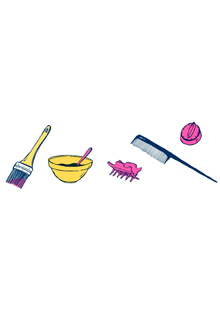Can You Use a Paint Brush to Apply Hair Dye

Photo: Alex Beauchesne
The right haircolor can transform your looks—enliven your skin tone, cover grays, add sparkle to your eyes. But getting color at the salon can run upwards (in some places, way upwards) of $75. So, in the spirit of fiscal responsibility, we enlisted a world-class professional colorist to give a step-by-step tutorial on exactly how to color your hair at home—for a lot less.
Happily, the technology has come a long way in the 50-plus years since Clairol debuted its first do-it-yourself kit. "The dyes today are not only less damaging but more translucent," says our professor, Sharon Dorram of Sharon Dorram Color at Sally Hershberger in New York City. "You no longer get dense, monotone shades." (We also noticed that the dyes smell far less acrid than they used to.) With Sharon at the blackboard—yes, that's her at left—we recruited three women to enroll in Home Haircolor 101. She guided them through the entire process, from shade selection to final blow-out. If you're ready to dye at home, don't start before reading these 5 simple rules:
- Be Conservative: Don't choose a color more than two to three shades lighter or darker than your natural color.
- Enlist a Friend to Help: She can ensure that you don't miss a spot on the back of your head.
- Use Natural Light: The forgiving dimmer switch in your bathroom won't do you any favors when you're trying to gauge the intensity of a new haircolor.
- Always Condition: Most kits come with a tube of deep conditioner. Use it right after you rinse out the dye, then do a deep-conditioning treatment at least once a week after that. It will help preserve color and shine.
- After Your First Time, Dye Only Your Roots: Your hair will get brittle, and your color patchy, if you recolor your whole head every six weeks. When your roots start to show, apply dye only to the regrowth; comb it through the rest of your hair a few minutes before the processing time is up.
Tools You Need Before You DyeBefore you begin any color job, you'll want to have on hand a few items that don't come in most haircolor boxes.
 Paintbrush: Unless your hair is quite short, it's easier to use than a bottle. The ideal brush is one and a half to two inches wide.
Paintbrush: Unless your hair is quite short, it's easier to use than a bottle. The ideal brush is one and a half to two inches wide.
Bowl: To mix up the dye, and swirl the brush in.
Clips: To hold back the rest of your hair as you work the dye through each section.
Rattail comb: Use the narrow pointed handle to divide hair into even sections, and the comb to distribute the dye.
Two dark towels: One to drape over your shoulders to protect your clothes; one to clean up any drips.
An alcohol-based facial toner: It helps remove stains from skin—and floors and countertops.
Timer: To make sure you don't wind up with a color very different from what you expected.
Before You Start, Make Sure to Do a Strand TestSometimes it's a great idea to jump headlong into a new project—but a home haircoloring session is not one of those times.
 You must ("must, must!" says Sharon) do a strand test to (1) make sure you like the color and (2) determine how long you need to leave the dye on. Here's how: Dye a section of hair a quarter to a half inch wide about a quarter inch above your ear (so you can see the color against your skin). Make sure it's underneath the top layer of your hair. Wipe off the color with a wet cloth after half of the designated processing time (i.e., 15 minutes if the box says 30). Blot dry, then check it against a white towel in natural light to get an accurate read of the shade. If you're happy with it, that's all the time you'll need. If it's not quite there yet, reapply dye for the remaining time and check color once more before committing your whole head.
You must ("must, must!" says Sharon) do a strand test to (1) make sure you like the color and (2) determine how long you need to leave the dye on. Here's how: Dye a section of hair a quarter to a half inch wide about a quarter inch above your ear (so you can see the color against your skin). Make sure it's underneath the top layer of your hair. Wipe off the color with a wet cloth after half of the designated processing time (i.e., 15 minutes if the box says 30). Blot dry, then check it against a white towel in natural light to get an accurate read of the shade. If you're happy with it, that's all the time you'll need. If it's not quite there yet, reapply dye for the remaining time and check color once more before committing your whole head.
Next: Jason Backe, Clairol's color director, shares what he knows about how to get salonlike results on your own
Follow these (general) rules. If your skin is... Fair
Avoid
Try a light auburn or rich honey blonde. Don't start overhighlighting, though; hair that's too blonde will wash you out.
Medium/Olive
Avoid red or copper hues, which can make your skin look sallow or orange.
Try a deep mahogany base that will warm up your skin tone; protect the color with a UV-shielding styling product (like Kérastase Crème UV Défense Active). Consider a few golden highlights for extra brightness.
Dark
Avoid going more than a couple of shades lighter than your natural color; the results could look brassy and make your skin tone seem flat.
Try weaving caramel or cinnamon highlights around your face and through the ends, where the sun would hit.
A Note on Gray
White hair, as long as it's shiny, will look stunning with any skin tone. Use a violet-tinged shampoo once a week (try Pantene Silver Expressions), avoid styling products with alcohol (they can dull silver), and smooth a silicone serum (like Paul Mitchell Smoothing Gloss Drops) over dry hair for extra sheen.
Jason Backe, Clairol's color director, shares what he knows about how to get salonlike results on your own.
In the Store:
1. Decide exactly what you want. To cover gray, you need a permanent dye, like Garnier Nutrisse Nourishing Color Treatment ($7.50). Time to touch up your roots? We love Clairol Nice 'n Easy Root Touch-Up ($7), a permanent dye that comes with a tiny application brush. For a slight shade change, try a semipermanent dye, like L'Oréal ColorSpa Moisture Actif, $8, which slowly rinses out over about four weeks.
2. Choose your color. Go no more than two shades lighter or darker than your current color. And use the chart on the back of the box to determine the shade you will get to from the color you have now.
1. Apply semipermanent dye to damp hair but permanent dye to dry hair.
2. Smooth Vaseline along your hairline, on your ears, and on the back of your neck to create a barrier that will keep dye from staining your skin.
3. If you're going darker, start applying color on front sections (where it's usually the lightest) first. If you're lightening up: Start in the back.
4. Leave the dye on as long as the instructions indicate—not a minute more.
Yes, it can be done! Three at-home makeovers you won't believe
Plus, two new at-home kits make the process even easier:
 Clairol Perfect 10 ($14)
Clairol Perfect 10 ($14)
This permanent haircolor uses a new lightening system (part of the permanent coloring process) based on hydrogen peroxide and the amino acid glycine. Because it doesn't contain the ammonium hydroxide that's in most formulas, it smells a whole lot better and has a lower pH—which means it's gentler on the hair, says independent cosmetic chemist Mort Westman. Best of all, the new technology allows this dye to get the job done in 10 minutes (compared with the usual 20 to 30).

Fekkai Salon Color ($30)
Most home kits come with an applicator tip that lets you squeeze the color directly onto your hair; this can make an even application tricky (and drippy). Fekkai's first-ever color kit comes with a bowl and brush just like the ones colorists use at his salons. The tools allow you to mix the color very thoroughly and work it through each strand—they also make it easy to use the product just for a root touch-up. The new line's 20 shades, from pale blonde to soft black, were created based on input from top Fekkai colorists.
From the November 2009 issue of O, The Oprah Magazine
Can You Use a Paint Brush to Apply Hair Dye
Source: https://www.oprah.com/style/how-to-dye-hair-at-home/all#:~:text=Before%20you%20begin%20any%20color,and%20swirl%20the%20brush%20in.
0 Response to "Can You Use a Paint Brush to Apply Hair Dye"
Post a Comment